Salou, Tarragona, Spain – Tuesday, May 11th, 2010
Ancient Greek mythology tells of a story between the demigod satyr Silenus, the old, drunken tutor to the god of wine and excess Dionysius, and whose wisdom and prophetic abilities came to him only when completely tanked; and Midas, the mortal Phrygian king later famous for his ability to turn whatever he touched to gold.
As King Midas was keenly interested to learn from Silenus, he laced a fountain which the old man often drank from, and after succumbing to sleep his servants brought Silenus to Midas’ court. Here he demanded from the drunken god to reveal to him the answer to this most important of questions:
“What is the most desirable thing amongst men?”
Silenus at first refused to answer, remaining stony silent. But as Midas further pressed, the god finally broke into a shrill laugh and spoke thus:
“Oh, wretched ephemeral race, children of chance and misery whose life is but for a day, why dost thou compel me to tell thee those things it is better thou wert ignorant of? For those live the least disturbed who know not their misfortunes…”
He continued with this answer:
“But for men, the best for them is not to be born at all. This should have the first place in our choice; however, for you this is no longer possible. The next best choice is, when we are born, to die as soon as we can.”
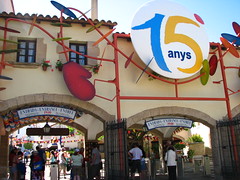 It was sometime around when I first stumbled off Furius Baco that afternoon that the wisdom of Silenus seemed the most reasonable. Since the time of the ancient Greeks, and perhaps even earlier, humans have sought to find a better reality than the miserable world presented to us by inventing metaphysical narratives positing such things as a hidden realm where the pure ideal forms and rational structure of being become openly manifest to understanding; a high-society culture that virtues above all else the “finer pleasures” of Apollonian moderation, grace and measure; or creating a perfect creator who promises justice when otherwise no justice would be found and an eternally blissful afterlife for those that accept at face value the rules of His game (did you know that heaven will be a year-round 72°F and you
It was sometime around when I first stumbled off Furius Baco that afternoon that the wisdom of Silenus seemed the most reasonable. Since the time of the ancient Greeks, and perhaps even earlier, humans have sought to find a better reality than the miserable world presented to us by inventing metaphysical narratives positing such things as a hidden realm where the pure ideal forms and rational structure of being become openly manifest to understanding; a high-society culture that virtues above all else the “finer pleasures” of Apollonian moderation, grace and measure; or creating a perfect creator who promises justice when otherwise no justice would be found and an eternally blissful afterlife for those that accept at face value the rules of His game (did you know that heaven will be a year-round 72°F and you never have to take a piss?). The universe doesn’t have to be a cold, chaotic bag of particles disorganizing themselves ever further with each passing nanosecond, but with whichever façade you find most pleasing all, it’s probably better to hurry up and find your releasement back into your world of pure ideas, ultimate love and/or infinite perfection. There’s very little this world has to offer the living.
never have to take a piss?). The universe doesn’t have to be a cold, chaotic bag of particles disorganizing themselves ever further with each passing nanosecond, but with whichever façade you find most pleasing all, it’s probably better to hurry up and find your releasement back into your world of pure ideas, ultimate love and/or infinite perfection. There’s very little this world has to offer the living.
Theme parks are one of modern society’s best examples of the attempts by people to suppose that there is some alternative world that is somehow better than the real world. Subtle about this fact they are not, with most of the marketing literature directly telling us that a theme park is a chance to escape from reality; to live in a world that’s a reflection of our own but only better;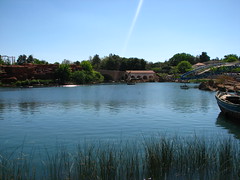 where a ‘visit’ to the Old West or Mexico or China is more representative of what those places mean in the collective consciousness than what it would be like to actually visit those locations themselves. While religion served as a pretty good opiate of the masses for a while, the 20th century proved that was not enough, and now we can add theme parks (among much else) to that list of sedatives.
where a ‘visit’ to the Old West or Mexico or China is more representative of what those places mean in the collective consciousness than what it would be like to actually visit those locations themselves. While religion served as a pretty good opiate of the masses for a while, the 20th century proved that was not enough, and now we can add theme parks (among much else) to that list of sedatives.
The irony of all this is that in reality, a visit to a theme park can be even more abysmally depressing than the toil of day-to-day living, if only because expectations were originally set at a much higher standard. My day didn’t start on the right foot when what should have been a simple walk from my hotel to the main gate somehow turned into over an hour of aimless wanderings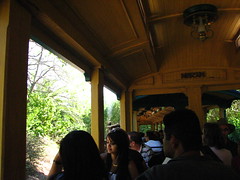 down an empty network of boulevard built nearby the premises, Hurakan Condor and Dragon Khan teasingly close, but eventually I realized a railroad track separated access between there and here so I had to return to my starting point and try again. Having long since missed my chance to beat the morning crowds when I finally entered the gate, I proceeded through the Mediterranean section, noting the Furius Baco was down due to mechanical problems, and hopped on the train to take me to the Far West, which would have been a pleasant journey also allowing for my first close-up looks at Dragon Khan from a unique angle had the park not been inexplicably packed and every bench on the train crowded shoulder to shoulder, making any photo opportunities while onboard rather difficult.
down an empty network of boulevard built nearby the premises, Hurakan Condor and Dragon Khan teasingly close, but eventually I realized a railroad track separated access between there and here so I had to return to my starting point and try again. Having long since missed my chance to beat the morning crowds when I finally entered the gate, I proceeded through the Mediterranean section, noting the Furius Baco was down due to mechanical problems, and hopped on the train to take me to the Far West, which would have been a pleasant journey also allowing for my first close-up looks at Dragon Khan from a unique angle had the park not been inexplicably packed and every bench on the train crowded shoulder to shoulder, making any photo opportunities while onboard rather difficult.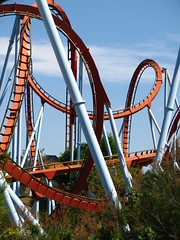
Breathing deep after being released from this moving sardine tin, I made a beeline for Stampida hoping to find a decent wait. What I was greeted with instead was one train operation on both sides with a dispatch interval not much faster than once every five minutes (and this was with new rolling stock from KumbaK whose principal advantage over the more flexible and comfortable PTCs was that they required no seatbelts). The queue accordingly was well over an hour. Waiting in a narrow, boxed-in cattle corral ramp up to the station platform, aware that I couldn’t escape even if I wanted to, I occupied myself by doing some math:
“There are four passengers in each six car train, that’s 24, with only one train on this track. I will assume the actual capacity per train to be twenty, as it is unlikely that there won’t be a couple empty seats on each train from single riders, and that’s just easier to calculate. The time from dispatch to dispatch according to my watch seems to average from four to five minutes, though I think there may have been some six minute outliers in there. 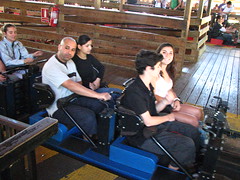 For ease of mental calculations, I’ll just say five minutes. Five minutes go into an hour twelve times. Multiply that by the twenty passengers per dispatch, and I’m looking at an hourly capacity just for this side of only 240. So that would be a total capacity of 480 per hour for the entire ride. That’s much less than a standard single track wooden coaster at most smaller parks, which I think are generally ideally listed between the 700 to 900 per hour range assuming they’re running both trains. And yet this is a dual track coaster at one of the largest and most popular theme park resorts on the entire European continent. Furthermore, for a day open from 10am to 6pm (eight hours) that’s 3840 people that can ride over a single day. Assuming an average daily attendance is around 10,000 that means from the park’s perspective only slightly more than 1/3
For ease of mental calculations, I’ll just say five minutes. Five minutes go into an hour twelve times. Multiply that by the twenty passengers per dispatch, and I’m looking at an hourly capacity just for this side of only 240. So that would be a total capacity of 480 per hour for the entire ride. That’s much less than a standard single track wooden coaster at most smaller parks, which I think are generally ideally listed between the 700 to 900 per hour range assuming they’re running both trains. And yet this is a dual track coaster at one of the largest and most popular theme park resorts on the entire European continent. Furthermore, for a day open from 10am to 6pm (eight hours) that’s 3840 people that can ride over a single day. Assuming an average daily attendance is around 10,000 that means from the park’s perspective only slightly more than 1/3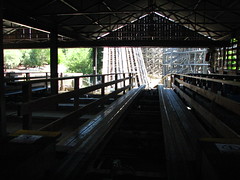 of their paying guests will physically be allowed to ride this during an operating day. Considering that they could easily double their capacity if they would just instruct their employees to add the second trains and motivate them to check restraints for dispatch a bit faster, this is unethical, nothing more than false advertising and profiteering, if they know that their attempts to cut down on maintenance and operations costs will mean that only a fraction of their guests will be able to do what they bought a ticket under the assumption that they’d be able to do. I should go to guest relations and leave a complaint for management explaining this. Or maybe I’ll just take the passive-aggressive approach, say nothing now and then rant about it on my blog several months later.”
of their paying guests will physically be allowed to ride this during an operating day. Considering that they could easily double their capacity if they would just instruct their employees to add the second trains and motivate them to check restraints for dispatch a bit faster, this is unethical, nothing more than false advertising and profiteering, if they know that their attempts to cut down on maintenance and operations costs will mean that only a fraction of their guests will be able to do what they bought a ticket under the assumption that they’d be able to do. I should go to guest relations and leave a complaint for management explaining this. Or maybe I’ll just take the passive-aggressive approach, say nothing now and then rant about it on my blog several months later.”
 Thankfully the junior-sized Tomahawk next door only had a queue requiring three or so cycles before it was my turn. I managed a ride in the back row, the seat-dividerless junior-sized PTC cars with buzzbars a welcome change from the molded foam individual seating and/or hydraulic lapbars present on every other wooden coaster I’ve experienced in Europe so far. The layout was a bit of a freeform oddity, designed to fit over, under and around the track for Stampida, and this tangle of wood made it at times difficult to judge just where it would be taking us next. After a somewhat steep first drop which doesn’t quite take us all the way down to ground level, there’s a rise into a flat turn buried inside Stampida’s lift structure, where it then flows into an elevated series of small dips and turns, mostly built to go over Stampida’s track. This feeds into a long midcourse curve that traces the inside of Stampida’s dueling helix section, which could potentially provide even better fly-by effects if the trains were dispatched frequently enough such that all three could likely be present at the same time.
Thankfully the junior-sized Tomahawk next door only had a queue requiring three or so cycles before it was my turn. I managed a ride in the back row, the seat-dividerless junior-sized PTC cars with buzzbars a welcome change from the molded foam individual seating and/or hydraulic lapbars present on every other wooden coaster I’ve experienced in Europe so far. The layout was a bit of a freeform oddity, designed to fit over, under and around the track for Stampida, and this tangle of wood made it at times difficult to judge just where it would be taking us next. After a somewhat steep first drop which doesn’t quite take us all the way down to ground level, there’s a rise into a flat turn buried inside Stampida’s lift structure, where it then flows into an elevated series of small dips and turns, mostly built to go over Stampida’s track. This feeds into a long midcourse curve that traces the inside of Stampida’s dueling helix section, which could potentially provide even better fly-by effects if the trains were dispatched frequently enough such that all three could likely be present at the same time.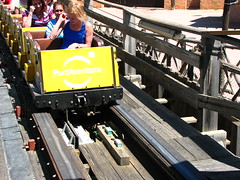 From here it’s another elevated series of minor dips and turns, reminiscent slightly of the style seen on Mt. Olympus’s Pegasus; good for the kiddies and a slightly different sense of pace than what enthusiasts are normally used to. A final surprise drop inside Stampida’s support structure might be the first to take us all the way to ground level, and from the back seat especially this was a nifty little conclusion to end the ride on, the airtime made more effective by the combination of headchoppers and buzzbar. Another example of Europeans doing a family coaster correctly, I took an immediate reride if only because I was doubtful there would be much else in the park this good I could do this easily.
From here it’s another elevated series of minor dips and turns, reminiscent slightly of the style seen on Mt. Olympus’s Pegasus; good for the kiddies and a slightly different sense of pace than what enthusiasts are normally used to. A final surprise drop inside Stampida’s support structure might be the first to take us all the way to ground level, and from the back seat especially this was a nifty little conclusion to end the ride on, the airtime made more effective by the combination of headchoppers and buzzbar. Another example of Europeans doing a family coaster correctly, I took an immediate reride if only because I was doubtful there would be much else in the park this good I could do this easily.
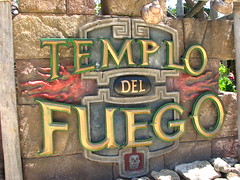 Heading into México (which I originally thought would be a little redundant with the Far West next door before I discovered it was less a “south-of-the-border” envisioning of the country as most Americans tend to think of our southern neighbor and pulled more from the further south Mayan civilization), I made Templo del Fuego my next port of call, which at first mercifully appeared to have a walk-on queue, but discovering paradoxically this meant I would have the longest wait than anyone else, as I ended up being the first in line after the previous show had been let in and therefore needed to stand by for the equivalent of two show cycles. No matter, the two-set special effects extravaganza would be worth it, made better than a similar attraction at the Walt Disney Studios Park by prominently including human actors
Heading into México (which I originally thought would be a little redundant with the Far West next door before I discovered it was less a “south-of-the-border” envisioning of the country as most Americans tend to think of our southern neighbor and pulled more from the further south Mayan civilization), I made Templo del Fuego my next port of call, which at first mercifully appeared to have a walk-on queue, but discovering paradoxically this meant I would have the longest wait than anyone else, as I ended up being the first in line after the previous show had been let in and therefore needed to stand by for the equivalent of two show cycles. No matter, the two-set special effects extravaganza would be worth it, made better than a similar attraction at the Walt Disney Studios Park by prominently including human actors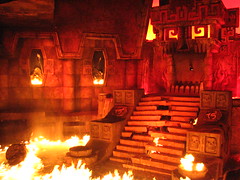 amongst all the marauding destruction. I couldn’t easily tell what the specifics of the storyline were due to my limited proficiency in Spanish, but I got the sense that the skinnier clean-shaven guy was attempting to locate the Temple of Fire for pure-hearted academic reasons, while the chubbier comic-relief counterpart was in it for the gold and glory. Regardless, I’m more likely to smile at a human telling me a story I can’t understand than a computer telling me a story I can understand; it’s the recognition of real effort and emotion that gives a live performance its immediacy that counts.
amongst all the marauding destruction. I couldn’t easily tell what the specifics of the storyline were due to my limited proficiency in Spanish, but I got the sense that the skinnier clean-shaven guy was attempting to locate the Temple of Fire for pure-hearted academic reasons, while the chubbier comic-relief counterpart was in it for the gold and glory. Regardless, I’m more likely to smile at a human telling me a story I can’t understand than a computer telling me a story I can understand; it’s the recognition of real effort and emotion that gives a live performance its immediacy that counts.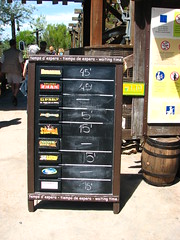
After moving out of the introductory chamber and into the main show room, it doesn’t take long before a booby trap is set off resulting in the anger of the gods to rain pyrotechnic effects down upon us, which one actor stayed on the set for a surprisingly longer length of time considering that portions of his platform were falling into the water and gigantic bursts of flames were shooting up nearby. The final few minutes were just standing around the outside of a set billowing flames and water eruptions, and you always know that the last fireball will be the smallest. There is a questionably patronizing revisionism to this tale especially as it is told in Spain, in which the Spanish explorers meet the mysterious indigenous culture and subsequently get a can of whupass opened on their ignorant bums, unlike the actual story in which the Spanish explores meet the mysterious indigenous culture and subsequently enslave and/or kill them all through foreign diseases.
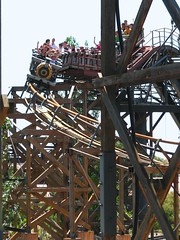 Hurakan Condor appeared to be using only half of its six available tower faces and was posting a queue of an hour in length so I skipped it and moved onward to El Diablo, an Arrow Dynamics mine train, one of their last having opened with the park in 1995. Pleasantly I found this to have a relatively short wait as it was running two trains. Situated in the front row I was a bit surprised by my excitement for this because I didn’t have much idea what the layout would be like and so would discover first hand as I experienced it.
Hurakan Condor appeared to be using only half of its six available tower faces and was posting a queue of an hour in length so I skipped it and moved onward to El Diablo, an Arrow Dynamics mine train, one of their last having opened with the park in 1995. Pleasantly I found this to have a relatively short wait as it was running two trains. Situated in the front row I was a bit surprised by my excitement for this because I didn’t have much idea what the layout would be like and so would discover first hand as I experienced it.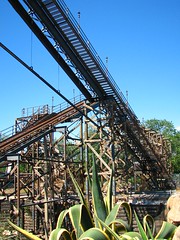
Starting with a drop out of the station into a trench running alongside an opposing track, it makes a circle around a large rock dug out in a gully. A lifthill hoists us above terra firma, where a shallow, curving runaway drop over the flume leads into a couple of decidedly dynamic looping switchback hills, the long train mixed with a guesswork force design making one want to hang on,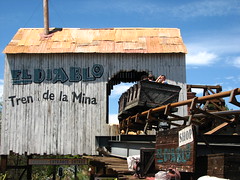 or cover their face from any random splashes of water on one of the dips beneath the log flume channel. It’s not allowed to go too far with this before a brake run anticipates a second lift hill. Like the first, this one starts with a small dip into a long, descending stretch of track that curves around to the left, but unlike the first, there’s nothing of interest at the end save for a series of trim brakes, a right turn, and then a second block brake run into a third lift crossing beside the first. Again, there’s a small dip followed by a shallow curving drop which picks up a bit of speed, running alongside the first
or cover their face from any random splashes of water on one of the dips beneath the log flume channel. It’s not allowed to go too far with this before a brake run anticipates a second lift hill. Like the first, this one starts with a small dip into a long, descending stretch of track that curves around to the left, but unlike the first, there’s nothing of interest at the end save for a series of trim brakes, a right turn, and then a second block brake run into a third lift crossing beside the first. Again, there’s a small dip followed by a shallow curving drop which picks up a bit of speed, running alongside the first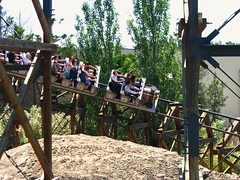 bit of track out of the station in the tunnel, concluding with a fast upward helix which kills most of the speed, the coda a slow meander through the signature El Diablo photo spot and around a final turn into the brakes.
bit of track out of the station in the tunnel, concluding with a fast upward helix which kills most of the speed, the coda a slow meander through the signature El Diablo photo spot and around a final turn into the brakes.
Almost a good ride, with at least four separate ‘segments’ (pre-lift; 1st lift; 2nd lift; 3rd lift), but unfortunately none of these segments feel like they were completely fleshed out, with bits like the pre-lift that are normally supposed to be teasers actually offering some of the layout’s most interesting content. I heard that somewhere after the 2nd lift Arrow actually ran out of money (presumably a signal from their late-life decline and pending bankruptcies) and had to improvise a new layout that cut down on materials as drastically as they could (this would explain why the track after the second lift has virtually no significant uphill sections). One wishes they could have simply cut out either the second or third lift instead and offered a continuous final act rather than waste time and energy on unnecessary chain lift drives, but the basic joys of an Arrow mine train remain intact especially though the more interesting canyon and s-curve parts, and it remains the only one of its ilk anywhere on European soil, where “mine trains” are often
the second lift has virtually no significant uphill sections). One wishes they could have simply cut out either the second or third lift instead and offered a continuous final act rather than waste time and energy on unnecessary chain lift drives, but the basic joys of an Arrow mine train remain intact especially though the more interesting canyon and s-curve parts, and it remains the only one of its ilk anywhere on European soil, where “mine trains” are often defined as Mack powered coasters.
defined as Mack powered coasters.
Next up in China was Dragon Khan. The entire queue house containing row after row of endless switchbacks was nearly full. The ride appeared to be silent… no, no, wait; there it goes, the lone single train servicing this massive track. A nearly two hour wait ensued from this piss-poor operational standard, my capacity calculations suggested somewhere between 300 to 400 people per hour. I later discovered the second train appeared to be having work done on its zero-car and the third train was nowhere in sight of the maintenance bay. My wait was not appeased any by the average Spaniard’s rather vague definition of what ‘line jumping’ is and is not. (For reference should you find yourself in the country, it is not saving a spot for your friends to join you at the head of the queue, but it is being a single rider told by an attendant to wait your turn for the next train so the group of four behind you can all ride together on this cycle.)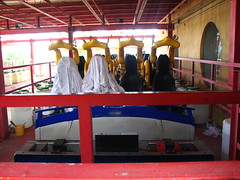
Getting to the station and realizing that despite paying to spend two days at the park this could easily be one of a rare few rides I would ever get, I wanted to make the most of my time spent waiting and added a marginal amount more time to secure a spot in the front row. I really wanted to like my ride, but I overshot it and tried too hard to enjoy myself. Like paying $15 for a ‘gourmet’ chocolate bar, the awareness of how much every moment with your hard-earned prize cost you only turns it to ash in your mouth, and by the end of the brake run I honestly couldn’t say the ride meant anything significant to me other than the only payoff at the end of spending around 20-25% of my available time for that day.
The Chinese section of the park appears to have not undergone much significant redevelopment since the park opened in 1995, and besides Dragon Khan there were a few flat rides that didn’t strike me as anything particularly unique, and a very lengthy elevated pathway (I think a weak attempt at the Great Wall of China?) devoid of anything to do besides make trekking from one side of the park to the other that much more wearying on your feet (and also some decent photo-op spots for Dragon Khan). Polynesia struck me as similarly bare, all theme with almost no worthwhile rides save for a splashdown flume I didn’t want to risk a long wait just to get water poured over my head for. A Vekoma roller skater coaster was supposed to be present as well, but I couldn’t for the life of me find it the first time I passed through. Later I discovered it was fenced off due to construction for remodeling the existing themed children’s section into a Sesame Street area instead… because management obviously realized that Sesame Street was more thematically continuous with their immersive Polynesian themeing and weren’t simply trying to inflate their stock prices by jumping on the bandwagon that dictates to every other entertainment corporation that no child shall go unmolested by as many international franchises (with all their tie-in opportunities!) as conceivable during their most impressionable years.
but I couldn’t for the life of me find it the first time I passed through. Later I discovered it was fenced off due to construction for remodeling the existing themed children’s section into a Sesame Street area instead… because management obviously realized that Sesame Street was more thematically continuous with their immersive Polynesian themeing and weren’t simply trying to inflate their stock prices by jumping on the bandwagon that dictates to every other entertainment corporation that no child shall go unmolested by as many international franchises (with all their tie-in opportunities!) as conceivable during their most impressionable years.
Having completed a near-complete loop of the park I was back at the Mediterranean entrance zone, where I discovered the last major coaster on my checklist, the new-for-2007 Furius Baco, was running two of its three trains and therefore had a posted wait time of only fifteen minutes. Finally, my day was going a bit closer to what I had planned.
the last major coaster on my checklist, the new-for-2007 Furius Baco, was running two of its three trains and therefore had a posted wait time of only fifteen minutes. Finally, my day was going a bit closer to what I had planned.
While the ride system itself was supplied by Intamin, the rest of Furius Baco was envisioned by Thinkwell, who I think did a better job as architects than John Wardley’s original work seen throughout the rest of the park. The outdoor queue is set in a terraced grape vineyard, and the station looks the part better than the typical square boxes you find, although (perhaps by necessity) the meta-themeing makes the overall concept rather strange. Given the amount of effort put into the ride’s appearance,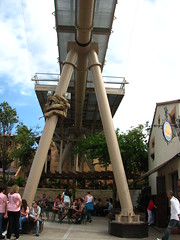 I’m slightly surprised to find they’d settle on a final design in which the brake run is built over the main entry midway sticking out like a sore thumb. As for the ‘story’ behind the ride experience… well, I really have to think Thinkwell weren’t thinking very well. It’s a difficult theme zone to fit a high-speed coaster into, but rather than rise to the challenge they just sort of awkwardly fitted the traditional themed thrill ride narrative in where it didn’t work.
I’m slightly surprised to find they’d settle on a final design in which the brake run is built over the main entry midway sticking out like a sore thumb. As for the ‘story’ behind the ride experience… well, I really have to think Thinkwell weren’t thinking very well. It’s a difficult theme zone to fit a high-speed coaster into, but rather than rise to the challenge they just sort of awkwardly fitted the traditional themed thrill ride narrative in where it didn’t work.
“Alright boys, name the first things that come to your mind: something you see in the Mediterranean, a way to make it go really fast, an unexpected plot twist, and an inherently funny animal.”
“Wine! A crazy inventor! An experiment gone wrong! Monkeys!”
“I like it!”
 I can imagine Sandor Kernacs was slightly miffed when told the prototype vehicles they spent countless time, money and research to bring to the cutting edge of technology would be made to look like brown wooden barrels, and whoever thought that making it “a flying grape collecting machine operated by a monkey” would be a good idea probably took one too many dives into their wine vat. The sad thing is that for as weird as this story is, at the same time it screams ‘adherence to convention’ just a bit too loudly and doesn’t go all-out Kafka as they probably should have done when they realized high-speed coasters and southern European countryside mix as well as beer and wine.
I can imagine Sandor Kernacs was slightly miffed when told the prototype vehicles they spent countless time, money and research to bring to the cutting edge of technology would be made to look like brown wooden barrels, and whoever thought that making it “a flying grape collecting machine operated by a monkey” would be a good idea probably took one too many dives into their wine vat. The sad thing is that for as weird as this story is, at the same time it screams ‘adherence to convention’ just a bit too loudly and doesn’t go all-out Kafka as they probably should have done when they realized high-speed coasters and southern European countryside mix as well as beer and wine.
The preride show room is an interesting way to lengthen what would otherwise be a fairly short experience, and the use of dark ride storytelling is something generally missing from rides you see on record-holding top ten lists (when it opened Furius Baco was just shy of the top ten fastest coasters in the world, although I daresay Superman: The Escape ever managed to surpass 83.9mph later in its life). And then the ride launches, and there’s a unique, high thrill roller coaster at the end of it. At the end of the launch track, rather than pull up like every other launched coaster ever built, the track dives down into a trench. The layout never goes more than 50 feet above the ground, which at these speeds provide a markedly different approach to pacing than anything I’ve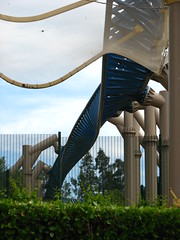 experienced before, the normal fast-slow-fast-slow dynamic provided by hills and loops wholly absent in favor of something new and subversive. It starts with a couple high speed switchbacks in which the sense of speed is even more heightened by the close proximity to the surroundings and precariously sensitive position afforded by the wing-dinger car design. The inline twist in particular is a unique element in this circumstance due to the absence of any heartline in the extra wide vehicles; sit on the left or right side and you’ll get very different sensations. All in all a very effective and thrilling, if not short ride, one that I applaud for its vision to provide a wholly new style of riding experience that relies solely on the pure visceral sensation of high exposure to fast speed and turns without the standard line-up of ‘roller coastery’-type elements giving it a more traditional rhythm.
experienced before, the normal fast-slow-fast-slow dynamic provided by hills and loops wholly absent in favor of something new and subversive. It starts with a couple high speed switchbacks in which the sense of speed is even more heightened by the close proximity to the surroundings and precariously sensitive position afforded by the wing-dinger car design. The inline twist in particular is a unique element in this circumstance due to the absence of any heartline in the extra wide vehicles; sit on the left or right side and you’ll get very different sensations. All in all a very effective and thrilling, if not short ride, one that I applaud for its vision to provide a wholly new style of riding experience that relies solely on the pure visceral sensation of high exposure to fast speed and turns without the standard line-up of ‘roller coastery’-type elements giving it a more traditional rhythm.
That was close to the review I wanted to write for this ride. After getting off my first ride in an outside row nearer the back of the train, the review I actually had to write looked something like this:
“Ow, ow, ow, ow, ow, ow, ow, ow, ow, ow, ow, ow, ow, ow, ow, ow, ow, ow, ow, ow, ow, ow, ow, ow…”
Hopefully if you’ve read enough of this site you’ll know that I am not one to easily (if ever) cave into the whole “it’s too rough” line of criticism, especially when there are so many better ways to bash a coaster. To list just a few coasters over which I have penned the words “it’s not that rough” (or some derivative): Mantis, Iron Wolf, Superwirbel, Space Mountain DLP, Son of Beast, and numerous Vekoma SLCs, among many others.
 Furius Baco is rough. To the degree that after the first curve you stop even trying to curse it out and simply want to curl up into the fetal position the way a Russian soldier curls up in the snow to accept their fate after 1000 days of bloody siege. When I first heard these reports from opening year I dismissed them as I normally do enthusiast banter on the subject of noggin-joggin’, but I honestly think it may have been understated; perhaps the calibration has even further deteriorated. It’s not the sloppy shuffling of a wooden coaster or the punchy slams of an older steel coaster. The cars pick up an extremely fine vibration that becomes greatly amplified in size (I’d estimate around an inch on the outside) but not reduced in frequency as you move further out over the length of the wing.
Furius Baco is rough. To the degree that after the first curve you stop even trying to curse it out and simply want to curl up into the fetal position the way a Russian soldier curls up in the snow to accept their fate after 1000 days of bloody siege. When I first heard these reports from opening year I dismissed them as I normally do enthusiast banter on the subject of noggin-joggin’, but I honestly think it may have been understated; perhaps the calibration has even further deteriorated. It’s not the sloppy shuffling of a wooden coaster or the punchy slams of an older steel coaster. The cars pick up an extremely fine vibration that becomes greatly amplified in size (I’d estimate around an inch on the outside) but not reduced in frequency as you move further out over the length of the wing.
 By the time you get to the end of the layout the relentless, unvarying high speed leaves your internal organs feeling like purée. Whatever unique or commendable qualities this layout might have had reduced to nothing more than a 30-second endurance test in which the end can’t come soon enough; at least on other rough coasters there’s a ‘teasing’ structure between slower, manageable parts and those moments of brutality. Even if the vibration could somehow be muffled, the slightest residual amount of roughness will instantly reel back to earth a layout concept that should otherwise suggest dream-like flight of visceral high-speed ecstasy. It doesn’t help that Stengel and Intamin still haven’t fully mastered smoothing their rotational movements. Most of the times when a banking transition occurs, the rate of rotation around the center of gravity remains linearly constant with little lead-in or out before the movement goes back to following a fixed curve or straight piece of track. This is especially obvious on the final transition to the brake run; it can be seen in a fixed POV how the rate of rotation simply stops (1:38), the nose jolts relative to the camera. It seems that while they’ve figured out how to properly design the train’s path through space for the desired gravitational forces,
By the time you get to the end of the layout the relentless, unvarying high speed leaves your internal organs feeling like purée. Whatever unique or commendable qualities this layout might have had reduced to nothing more than a 30-second endurance test in which the end can’t come soon enough; at least on other rough coasters there’s a ‘teasing’ structure between slower, manageable parts and those moments of brutality. Even if the vibration could somehow be muffled, the slightest residual amount of roughness will instantly reel back to earth a layout concept that should otherwise suggest dream-like flight of visceral high-speed ecstasy. It doesn’t help that Stengel and Intamin still haven’t fully mastered smoothing their rotational movements. Most of the times when a banking transition occurs, the rate of rotation around the center of gravity remains linearly constant with little lead-in or out before the movement goes back to following a fixed curve or straight piece of track. This is especially obvious on the final transition to the brake run; it can be seen in a fixed POV how the rate of rotation simply stops (1:38), the nose jolts relative to the camera. It seems that while they’ve figured out how to properly design the train’s path through space for the desired gravitational forces,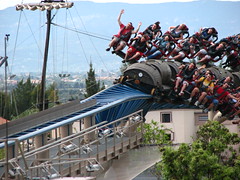 banking rotation is still calculated by simple geometry.
banking rotation is still calculated by simple geometry.
This describes more appropriately my experience on outside rows nearer the back of the train, a single experience in the front inside seat the next day yielded much better results, although after previous experiences to say that I was able to simply enjoy that ride without any apprehensions would be a lie. I should have listened more seriously to warning and made my first ride a front inside row such that I would have had at least one time with Furius Baco that I might have unequivocally enjoyed at some level, but after giving it two game but unsuccessful attempts the first day and staggering off with my first genuine headache from a roller coaster in many, many years (not counting the neck-base tension Diamondback gave me after a reride session in the cold the previous autumn), I had permanently lost any potential future goodwill.
with Furius Baco that I might have unequivocally enjoyed at some level, but after giving it two game but unsuccessful attempts the first day and staggering off with my first genuine headache from a roller coaster in many, many years (not counting the neck-base tension Diamondback gave me after a reride session in the cold the previous autumn), I had permanently lost any potential future goodwill.
After I had finished with Furius Baco I had enough time to give the park another quick loop around where I passed on virtually everything save for the mine train, and ended up at Dragon Khan, where crowds had dissipated enough such that I only had slightly more than a thirty minute wait. I once again tried to enjoy a back row ride in what should have been the best attraction in the park, but all it served to do was exacerbate my lingering headache and all I recall is pulling around the final turn with gritted teeth.
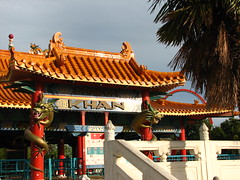 I’m not sure how it could happen that at a park featuring a highly-themed Intamin prototype coaster ranking as one of the fastest in the world, a B&M mega-looper with more inversions than any the company has ever tried in the past, and the only twin-tracked fully racing coaster by one of my most preferred design firms CCI, my greatest pleasures by the end of the day would have been on a small junior woody and a middling mine train layout… but happen it did. I wandered back to my hotel, uploaded the days photos to my laptop, then tried to find a cheap dinner in Salou as my only meal that day had been a free breakfast buffet. I hoped tomorrow would be better, and my faith restored in the popular narrative that B&M and Intamin are the most desirable things amongst men.
I’m not sure how it could happen that at a park featuring a highly-themed Intamin prototype coaster ranking as one of the fastest in the world, a B&M mega-looper with more inversions than any the company has ever tried in the past, and the only twin-tracked fully racing coaster by one of my most preferred design firms CCI, my greatest pleasures by the end of the day would have been on a small junior woody and a middling mine train layout… but happen it did. I wandered back to my hotel, uploaded the days photos to my laptop, then tried to find a cheap dinner in Salou as my only meal that day had been a free breakfast buffet. I hoped tomorrow would be better, and my faith restored in the popular narrative that B&M and Intamin are the most desirable things amongst men.
Wow, that transition from curve to final brakes is unacceptable, especially seen from off-ride.